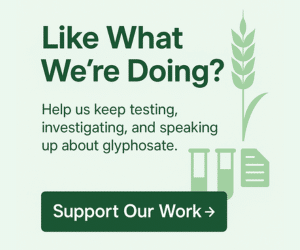When we think about glyphosate’s impact on pollinators, we often picture dwindling food sources, contaminated nectar, or weakened hives.
But a new scientific study has found something even more alarming: glyphosate doesn’t just harm bees through ingestion—it disrupts their biology on a genetic level through simple contact.
Researchers studying Africanized honey bees (Apis mellifera) discovered that even brief physical exposure to glyphosate altered the expression of genes in the head of the bees. These weren’t just any genes—the affected pathways were linked to neurodevelopment, immune system regulation, and cellular detoxification.
Why This Matters
Bees don’t just pollinate crops. They pollinate ecosystems. And when glyphosate interferes with their neurological and immune systems, it raises more than ecological red flags—it triggers questions about what we’re doing to our shared environment.
These findings suggest that bees flying through recently sprayed areas, walking across contaminated petals, or cleaning themselves after exposure to sprayed surfaces could experience subtle but significant genetic disruptions. Over time, this could impair brain function, decision-making, foraging efficiency, or disease resistance.
In short: glyphosate is getting into their heads. Literally.
Not Just a Bee Problem
This isn’t the first study to raise alarm about glyphosate and pollinators. But what makes this one so important is that it shows contact exposure alone is enough to trigger biological changes. Not eating contaminated pollen. Not chronic exposure. Just brief contact.
That should be deeply concerning for anyone who sprays glyphosate-based weedkillers in flowering areas, along fence lines, or near pollinator habitats. It also raises an uncomfortable question:
If glyphosate can alter gene expression in the tiny brain of a bee after minor exposure, what might it be doing to us?
The Local Angle
Here in New Zealand, bees aren’t just vital to biodiversity—they’re central to our agriculture and economy. Yet we continue to allow widespread glyphosate spraying around homes, schools, public parks, vineyards, and even roadside verges.
Many of these areas contain flowering plants that attract pollinators. And with the Ministry for Primary Industries considering raising allowable glyphosate residue limits on dozens of food crops, the window of exposure is likely to grow wider.
It’s not just about what ends up in the honey. It’s about what happens to bees on the way there.
What Can Be Done?
- Stop spraying flowering plants and trees. Bees don’t know the difference between a wildflower and a treated weed.
- Avoid glyphosate-based herbicides in home gardens, school grounds, and parks.
- Push councils and government to adopt bee-safe practices.
- Support organic and regenerative growers who use alternatives to glyphosate.
Final Thought
We’ve long known that glyphosate harms bees by removing their food sources. But this new research suggests a deeper, more insidious harm. It’s not just ecological. It’s genetic.
And if that’s what’s getting into their heads—what’s getting into ours?
Resources & References:
If we want to protect pollinators, we have to start looking beyond visible harm. The following studies and articles offer deeper insight into what glyphosate is really doing—not just to the landscape, but to the very biology of bees.
Glyphosate contact alters the expression of genes in the head of Africanized Apis mellifera bees
This study investigates the effects of glyphosate exposure on the gene expression in the heads of Africanized honey bees (Apis mellifera). Bees were exposed to both lethal and sublethal doses of glyphosate through contact, and their gene expression profiles were analyzed after one and four hours. The results revealed significant alterations in gene expression, particularly in genes associated with neural function, immune response, and metabolism. These findings suggest that even brief contact with glyphosate can disrupt critical biological processes in honey bees, potentially impacting their health and the broader ecosystem services they provide.
Full Text: ResearchGate Link
Bee declines driven by combined stress from parasites, pesticides, and lack of flowers
This comprehensive review highlights that bee populations are declining due to a combination of stressors: exposure to pesticides, parasitic infections, and the loss of floral resources. The authors emphasize that these factors often interact synergistically, exacerbating their individual effects. For instance, pesticide exposure can impair bees’ immune systems, making them more susceptible to parasites. The study underscores the need for integrated approaches to mitigate these stressors and protect pollinator health.
PubMed Link: https://pubmed.ncbi.nlm.nih.gov/25721506/
Related articles on nomoreglyphosate.nz
Where Have All the Pollinators Gone?
This article explores the troubling decline in bee and pollinator populations across New Zealand and the world. It highlights the role of glyphosate-based herbicides in habitat destruction, direct toxicity, and weakened ecosystems—and asks whether our chemical habits are pushing nature’s essential workers to the brink.
Read the article
Why Raising MRLs Threatens Public Health
With MPI proposing higher glyphosate residue limits on food crops, this article breaks down what MRLs really mean—and why raising them could put everyday New Zealanders at greater risk. It questions the science behind these limits and asks whether our regulators are protecting health or just aligning with industry convenience.
Read the article
Further reading:
The following books are linked to Amazon.com for your convenience. If you decide to purchase through these links, we may earn a small commission — at no extra cost to you.
Toxic Legacy: How the Weedkiller Glyphosate Is Destroying Our Health and the Environment
In her book Toxic Legacy, Dr. Stephanie Seneff presents a comprehensive review of glyphosate’s potential health impacts, arguing that its widespread use is linked to numerous chronic diseases, including autism. She emphasizes the need for a reevaluation of glyphosate’s safety.
Link: Toxic Legacy – Book Review
Whitewash: The Story of a Weed Killer, Cancer, and the Corruption of Science
By Carey Gillam
Investigative journalist Carey Gillam explores the history of glyphosate, its widespread use, and the controversies surrounding its safety assessments, shedding light on its potential risks to both human health and the environment.
Link: Whitewash [amazon.com]
Pollinator Protection: A Bee and Pesticide Handbook
By Kim Flottum
This handbook offers practical guidance on safeguarding pollinators from pesticide exposure, discussing the interplay between agricultural practices and bee health.
Link: Pollinator Protection [amazon.com]
Pollinators and Pollination: Nature and Society
By Jeff Ollerton
Jeff Ollerton provides an in-depth look at the vital role of pollinators in ecosystems and agriculture, discussing the challenges they face and the importance of their conservation.
Link: Pollinators and Pollination [amazon.com]
The Forgotten Pollinators
By Stephen L. Buchmann and Gary Paul Nabhan
This book highlights the essential services provided by pollinators and the threats they encounter, emphasizing the need for their protection to maintain biodiversity and food security.
Link: The Forgotten Pollinators [amazon.com]
Pollinators, Predators & Parasites: The Ecological Roles of Insects in Southern Africa
By Clarke Scholtz, Jenny Scholtz, and Hennie de Klerk
Focusing on the diverse roles of insects, this book examines their contributions to ecosystem functioning, including pollination, and the impacts of environmental changes on their populations.
Link: Pollinators, Predators & Parasites [amazon.com]
We’re only beginning to understand the true cost of glyphosate exposure. But the science is clear: if it’s changing the biology of bees, the ripple effects are already underway.
Image Source & Attribution
We’re grateful to the talented photographers and designers whose work enhances our content. The feature image on this page is by danielerusso. You can find more of their work here: https://www.123rf.com/profile_danielerusso.




